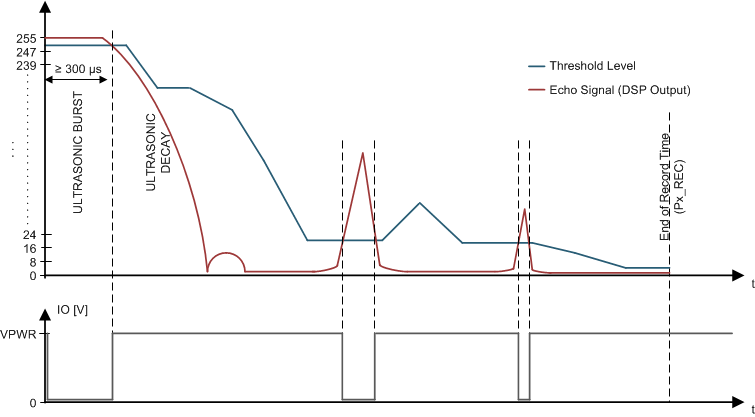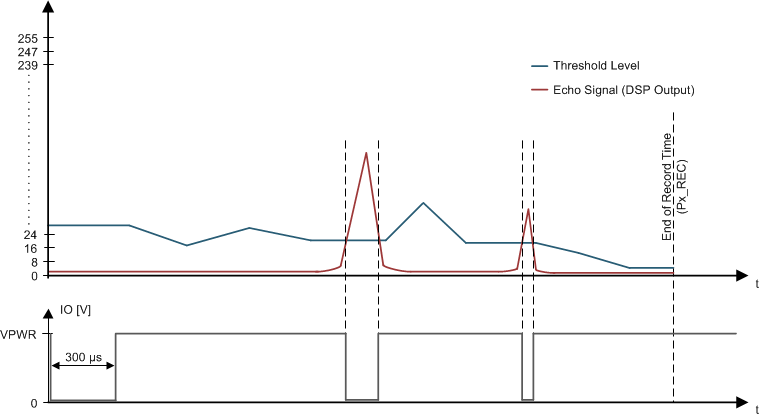SLASEJ4C April 2017 – February 2023 PGA460
PRODUCTION DATA
- 1 Features
- 2 Applications
- 3 Description
- 4 Revision History
- 5 Pin Configuration and Functions
-
6 Specifications
- 6.1 Absolute Maximum Ratings
- 6.2 ESD Ratings
- 6.3 Recommended Operating Conditions
- 6.4 Thermal Information
- 6.5 Internal Supply Regulators Characteristics
- 6.6 Transducer Driver Characteristics
- 6.7 Transducer Receiver Characteristics
- 6.8 Analog to Digital Converter Characteristics
- 6.9 Digital Signal Processing Characteristics
- 6.10 Temperature Sensor Characteristics
- 6.11 High-Voltage I/O Characteristics
- 6.12 Digital I/O Characteristics
- 6.13 EEPROM Characteristics
- 6.14 Timing Requirements
- 6.15 Switching Characteristics
- 6.16 Typical Characteristics
-
7 Detailed Description
- 7.1 Overview
- 7.2 Functional Block Diagram
- 7.3
Feature Description
- 7.3.1 Power-Supply Block
- 7.3.2 Burst Generation
- 7.3.3 Analog Front-End
- 7.3.4 Digital Signal Processing
- 7.3.5 System Diagnostics
- 7.3.6
Interface Description
- 7.3.6.1 Time-Command Interface
- 7.3.6.2
USART Interface
- 7.3.6.2.1 USART Asynchronous Mode
- 7.3.6.2.2 One-Wire UART Interface
- 7.3.6.2.3 Ultrasonic Object Detection Through UART Operations
- 7.3.6.3 In-System IO-Pin Interface Selection
- 7.3.7 Echo Data Dump
- 7.3.8 Low-Power Mode
- 7.3.9 Transducer Time and Temperature Decoupling
- 7.3.10 Memory CRC Calculation
- 7.3.11 Temperature Sensor and Temperature Data-Path
- 7.3.12 TEST Pin Functionality
- 7.4 Device Functional Modes
- 7.5 Programming
- 7.6 Register Maps
- 8 Application and Implementation
- 9 Device and Documentation Support
- 10Mechanical, Packaging, and Orderable Information
Package Options
Mechanical Data (Package|Pins)
- PW|16
Thermal pad, mechanical data (Package|Pins)
Orderable Information
7.3.6.1.1 RUN Commands
The run commands are used for device run-time operation and are most commonly used during the normal operation cycle of the PGA460 device. These device commands are specified by pulling the IO pull low for a specified period of time as defined in the GUID-6906D0A9-86EC-46B1-B4A5-F88035F60F0B.html#TITLE-SLASEC8TOCWRAPPER_SPECIFICATIONS section. The following are classified as run commands:
- Burst/Listen (Preset1)The device sends an ultrasonic burst using the P1_PULSE number of pulses while using the CURR_LIM1 current-limit setting and runs an object-detection record interval defined by the value of the P1_REC time length. During the process of object detection, the P1_THR_xx threshold map is used for signal comparison. The nonlinear scaling DSP function is available for use with this command.
- Burst/Listen (Preset2)The device sends an ultrasonic burst using the P2_PULSE number of pulses while using the CURR_LIM2 current-limit setting and runs an object-detection record interval defined by the value of the P2_REC time length. During the process of object detection, the P2_THR_xx threshold map is used for signal comparison. The nonlinear scaling DSP function is available for use with this command.
- Listen Only (Preset1)The device does not send an ultrasonic burst, however, and only runs an object-detection record interval defined by the value of the P1_REC time length. During the process of object detection, the P1_THR_xx threshold map is used for signal comparison. The nonlinear scaling DSP function is available for use with this command.
- Listen Only (Preset2)The device does not send an ultrasonic burst, however, but only runs an object-detection record interval defined by the value of the P2_REC time length. During the process of object detection, the P2_THR_xx threshold map is used for signal comparison. The nonlinear scaling DSP function is available for use with this command.
#X5872 shows the process of the communication of the IO pin run command.
The status field of the PGA460 device is embedded in the run command and provided back to the controller by extending the dead-time on the IO bus. The dead-time can be further extended for up to 3 × t(DT_TCI) which signifies three status bits, STAT[1:3]. Table 7-1 shows the assigned diagnostic and a priority of each status bit.
| STATUS BIT | PRIORITY | DESCRIPTION |
|---|---|---|
| STAT 1 | 1, low | Threshold settings uninitialized error |
| STAT 2 | 2 | Frequency diagnostics error |
| Voltage diagnostic error | ||
| STAT 3 | 3, high | Power-up auto EEPROM CRC error |
| User triggered EEPROM download CRC error |
As listed in Table 7-1, the STAT3 bit has the highest priority. When a STAT3 error condition is present, then the dead-time is further extended by 3 × t(DT_TCI). In this case, if any STAT2 or STAT1 error conditions are also present, these conditions are overruled by the higher priority of STAT3 error conditions. In a similar way, a STAT1 condition is overruled by a STAT2 error condition in which case the dead-time is further extended by 2 × t(DT_TCI). When all STAT3 and STAT2 error conditions have cleared, a STAT1 condition further extends the dead-time by an additional t(DT_TCI).
The functions of the status bits can be explained as follows:
- STAT 1This status bit is set to 1 when both preset threshold register groups are uninitialized. Any run command received over the TCI communications channel is not executed until either preset threshold register group is programmed.
- STAT 2This status bit is set to 1 when any of the following occurs:
- If the measured frequency value as described in the GUID-BC9FDDC3-E4C4-4B97-827D-A2FCEED52928.html#TITLE-SLASEC8X133 section for frequency diagnostics is higher or lower than the delta value defined by the FDIAG_ERR_TH parameter in the EEPROM memory (this is consider to be a frequency diagnostic error).
- If the measured voltage value as described in the GUID-BC9FDDC3-E4C4-4B97-827D-A2FCEED52928.html#TITLE-SLASEC8X133 section for transducer voltage measurement is lower than the level provided by the FVOLT_ERR_TH parameter in EEPROM memory.
- STAT 3Any run command received over the TCI communications channel is not executed until the EE CRC error is fixed.
The user can write to any EEPROM-mapped register to clear the error.
The user must reprogram the EEPROM to prevent the error upon another automatically or manually triggered EEPROM download operation.
When the device receives a run command, the IO pin is actively driven by the PGA460 device depending on the final DSP output to indicate object detection. If, at any time, the processed echo signal exceeds the threshold at that time, the IO pin is pulled low (GND, strong pulldown) otherwise the IO pin is pulled up by the internal 10-kΩ (weak pullup) resistor. When the record time reaches the end of the record defined by the Px_REC parameters, the IO pin is released (pulled up as an input) and the device is ready for a next command. #X4572 shows the object detection functionality of the IO pin. The device pulls the IO pin low during the burst and then releases it to provide a reference for the recording time-frame for the MCU. Knowing the time of reference, the duration of the programmed burst and following falling edges for each object detected, the controller or MCU can calculate the object distance.
 Figure 7-13 IO-Pin Object-Detection Signaling With Burst/Listen Time Command
Figure 7-13 IO-Pin Object-Detection Signaling With Burst/Listen Time Command Figure 7-14 IO-Pin Object-Detection Signaling With Listen-Only Time Command
Figure 7-14 IO-Pin Object-Detection Signaling With Listen-Only Time CommandThe PGA460 device forces IO pin to go low after the t(DT_TCI) time passes after receiving a run command for a minimum of 300 µs which indicates start of the record period. This process occurs to provide the controller a reference edge to start the time of flight measurement and also for PGA460 device to separate the response of the status (STAT) bits from the record cycle information. In general, the duration of burst for lower frequency range followed by ringing causes the AFE to saturate and pull the IO pin low for more than 300 µs. For higher frequency burst or for listen-only command, or in situations where the saturation caused by the ultrasonic burst might not be a higher value than the assigned threshold (see #X7681), the minimum pulse width is 300 µs. With a certain filter and deglitch setting, a fake object can be detected directly after this 300-µs period.